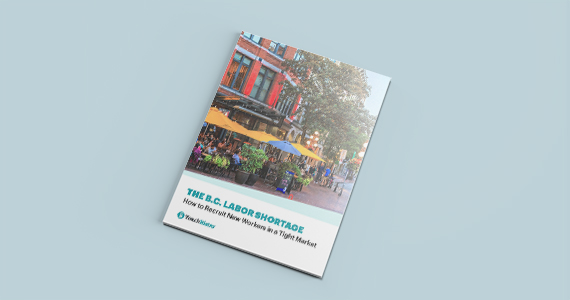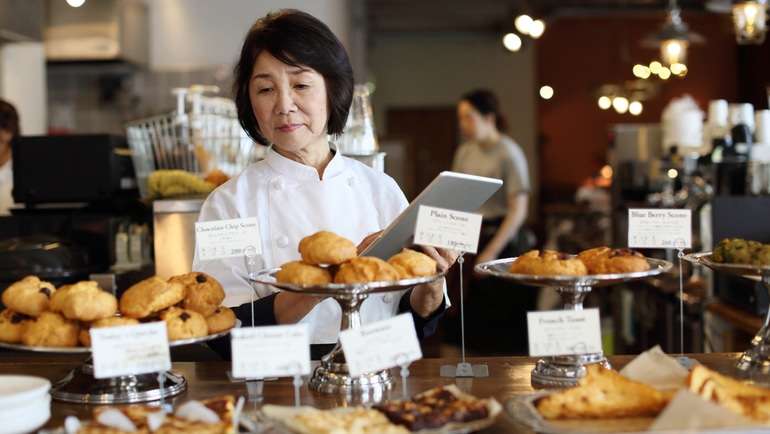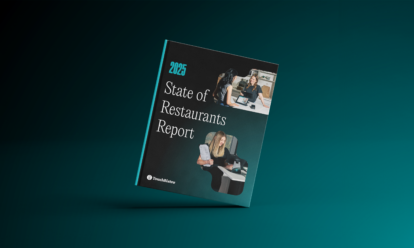British Columbia’s restaurant industry may be booming, but it’s also facing a massive labor shortage.
Across the province, restaurants are operating on skeleton crews or closing mid-week just to stay afloat. Some have even been forced to close their doors for good.
But while the province’s low unemployment rate seems the most likely cause of the labor shortage, it’s only half the story.
In B.C., a high cost of living, low wages, and a challenging work environment have also contributed to the widening employment gap – a gap that is expected to be 300,000 workers short in the next 10 years.
With B.C.’s restaurant industry employing 7.3% of the province’s entire workforce, this is definitely cause for alarm.
For restaurateurs, it’s clear that a new approach is needed when it comes to attracting and retaining staff – especially chefs and cooks.
To help you navigate this tight labor market, we’ll cover:
- The causes of B.C.’s labor shortage
- Tips for improving staff retention
- Strategies restaurateurs can use to attract new talent
Causes of the Labor Shortage
As most restaurateurs have heard, the restaurant labor shortage is not unique to B.C. Across Canada and the U.S., restaurant growth has far outpaced available labor.
But in B.C. specifically, a perfect storm of factors has come together to create an alarming labor shortage.
Below, we dive into the factors that have left many B.C. restaurants short on staff.
Strong Economy
Ironically, B.C.’s restaurant industry has been a victim of the province’s success. The B.C. economy is booming, making it a desirable place to live, work, and visit. As a result, the unemployment rate has dropped to record lows (the lowest in Canada) and few people are actively searching for work.
While this is great news for B.C., the flip-side is that residents have more options when it comes to employment. This means workers are passing over low-wage, less reliable restaurant jobs because they know that they have other options.

High Cost of Living
Beyond unemployment, one of the biggest drivers of the labor shortage is the cost of living. This not only includes the cost of renting or buying a home, but also the cost of fuel, insurance, electricity, and more.
This is especially true in Vancouver, where home prices are some of the highest in Canada, yet median household income is the lowest. According to PadMapper, the average rent for a one-bedroom in Vancouver is an eye-popping $2,200 per month. And other B.C. cities aren’t far behind, with Burnaby and Victoria clocking in as the third and fourth most expensive markets respectively.
Low Wages
B.C. minimum wage is increasing to just over $15 by 2021. However, the new B.C minimum wage still falls short of a living wage, which is the minimum income needed to meet one’s basic needs in that area.
Low wages are an issue for all restaurant staff, but especially for servers and bartenders who are paid a liquor server wage that falls below the B.C. minimum wage.
Though the gap between B.C. minimum wage and the liquor server wage will eventually be closed, this won’t happen until 2021. This makes B.C. an anomaly in Canada because most provinces (except for Ontario) don’t have this kind of separate wage.
Shifting Demographics
Traditionally, 15 to 24 year-olds have been the restaurant industry’s biggest labor pool. But in B.C, this demographic sweet spot is changing. The number of 15 to 24 year-olds is expected to shrink by 11% in the next five years. And of this small group, fewer young people are entering the workforce. As the B.C. Restaurant and Foodservices Association (BCRFA) found, “one out of every three retiring workers will not be replaced by young people entering the workforce.”
This trend has also been exacerbated by the changing expectations of younger workers. A survey by the BCRFA found that younger workers are looking for employers that offer competitive salaries, realistic hours, and tangible career development opportunities – things that the restaurant industry has not traditionally offered. This mindset is particularly worrisome when it comes to cooks and chefs who are not recommending the profession to their peers, family, or friends due to the strain on their work-life balance.
Employment Barriers for Foreign Workers
With fewer B.C. residents looking for work, the Temporary Foreign Worker Program has long helped to fill the restaurant labor gap. However, changes to the program in 2013 made it more difficult for employers to use it. Not only is the application process more rigorous, costs have also gone up. In fact, operators report incurring costs of up to $10,000 per employee in the time between application and acceptance.
This is particularly a problem for restaurants specializing in international culinary styles. Many restaurant operators in B.C. have found that the program’s English requirements are too strict, leaving them unable to hire foreign workers with the skills required to prepare specialty cuisines. As a result, only 3,600 of the 20,000 people in B.C.’s Temporary Foreign Worker Program were working in the restaurant industry as of 2016.
Beyond the Temporary Foreign Worker Program, restaurant operators also face new challenges when it comes to hiring international students from B.C. culinary programs. In the past, international students in B.C. programs could apply for a two-year apprenticeship style working visa upon graduation. However, students enrolled in programs that are less than two years in length are no longer eligible for these visas, leaving highly trained graduates unable to legally work in B.C..
Inadequate Labor Laws
To attract workers to the restaurant industry, the industry needs to be seen as a safe and welcoming environment. Unfortunately, B.C. labor laws have long fallen short when it comes to fostering a safe and supportive work environment for restaurant staff.
For instance, the Employment Standards Act requires just eight hours off between shifts. For employees with commute times of an hour or more – something that’s common due to the high cost of living in Metro Vancouver – this leaves little time for rest. And until April of 2019, employers were legally allowed to collect a portion of their server’s tips to put towards their operating costs, eating into employees’ already low wages.
Female restaurant staff have also suffered at the hands of B.C. employment standards. Until recently, restaurants in B.C. could legally require female servers to wear high heels on the job. For many female servers, this not only caused great discomfort, but also put them at risk of long-term musculoskeletal injury. In April of 2017, the high heel dress code was finally banned. However female restaurant workers often still contend with other types of harassment and discrimination.

Beat the BC labor shortage with these tips for hiring – and retaining – the best talent, despite the industry struggles.
Tips for Improving Worker Retention
With so few workers available, it’s more important than ever to hold on to the staff you already have – especially your back-of-house staff.
Reducing restaurant turnover not only saves you from the time-consuming recruitment process, but it also saves you a lot of money.
In B.C. the average cost to recruit, onboard, and train an entry-level worker is $3,000. For a skilled position, this figure balloons to $10,000.
Though some turnover is impossible to avoid, there are a few strategies B.C. restaurateurs can use to improve staff retention.
1. Provide Proper Training
While the idea of properly training your staff may seem like a no-brainer, it often gets overlooked. Time is money in the restaurant industry, and in a tight labor market, employers often cut corners on training to get staff on the floor faster.
However, proper training is an important part of staff retention. When workers feel confident in their skills, they’ll be more likely to stick around. Just consider your POS system. Mastering the POS is one of the biggest parts of staff training so you should make sure staff are comfortable using your system.
“TouchBistro is a really user-friendly software, especially after transitioning from a till. Saved me from the aches and pains of trying to train servers.”
Tomas Gabriel, owner of Tomas Gabriel in Nelson, B.C.
2. Smart Scheduling
The happiest employees are the ones with a healthy work-life balance. Remember, your staff have priorities outside of your restaurant and they won’t be thrilled if they constantly need to rearrange their personal lives. In fact, the go2HR Cook Labour Market Analysis found that cooks and chefs tend to exit their occupations early (between the ages of 35 and 44) due to poor work-life balance.
Showing your employees that you respect their time can be as simple as advanced scheduling. Predictable schedules help to reduce last-minute shift changes, cancellations, and overtime requests that can impact a workers’ daily routine. And for restaurateurs, smart scheduling can also help to lower labor costs.
One way to streamline the scheduling process is to invest in a scheduling software. With a mobile app like 7shifts, created specifically for restaurants, you can build your schedules that meet B.C. labor laws and keep employees happy.

3. Ask for Feedback
Exit interviews can be a great way to gather feedback when an employee decides to leave. But, an even better idea is to get their feedback before the employee heads for the door.
Scheduling employee evaluations or informal check-ins with your team can be a great way to find out how your staff are feeling about their job and restaurant management. Ask your staff what they enjoy about their job, their future goals, and what they’d like to change. If you catch problems early, you can address them before an employee gives notice.
4. Rewards and Recognition
Employees stick around when they feel their work is appreciated. Bonuses are one way to reward great work, but a little recognition can help to boost morale across the whole team. As the leadership development firm Zenger Folkman found, “69% of employees said they would put more effort into their work if they received acknowledgment of a job well done.”
An easy way to recognize your staff is to leverage your POS reports. If you notice that one of your servers has mastered the art of upselling, recognize their efforts and offer a small reward, such as letting the employee select their preferred shifts for a week. This not only makes the employee feel valued, it also shows others that hard work will be rewarded.
5. Long-Term Opportunities
If your restaurant doesn’t offer opportunities for advancement, employees will start to look elsewhere. This is especially true of younger employees who think of each job as an opportunity to build skills and advance their career.
One of the best ways to show employees that you care about the future of their careers is to offer additional training. Allow employees to job shadow or cross-train in other departments so they can gain new skills. You might also consider hosting industry-related classes or workshops.

6. Perks
When all else fails, it doesn’t hurt to sweeten the deal. Tempt employees to stick around by offering staff perks.
These perks can be as simple as free meals during shifts or something more creative. Some innovative employee perks include:
- Staff discounts during days off
- Friends and family discounts
- A benefits program for full-time workers
- Additional training through the Canadian Culinary Institute or Red Seal Program
- Mentorship programs (internal or external)
- Discounts at local businesses such as gyms or retailers
- Subsidized transportation
How to Recruit New Workers
While reducing staff turnover should be a top priority, you also need to have a solid recruitment and hiring strategy in place.
While one hiring strategy is to simply increase salaries, this will also increase your cost of labor – not ideal when profit margins are already tight.
Instead of simply offering new recruits more money, consider implementing different hiring strategies:
- Employee Referral Programs: Offer your existing employees a reward for recommending new hires.
- Hire Older Workers: Consider older workers as a new source of talent – especially for seasonal positions that require more flexibility.
- Look to Technology: Think about positions that don’t need to be filled and consider using technology instead.

While the B.C labor shortage does not appear to be ending any time soon, there is still time for restaurateurs to adapt to the changing market. By focusing on reducing employee turnover and taking a new approach to hiring, you can begin to close the labor gap.

Beat the BC labor shortage with these tips for hiring – and retaining – the best talent, despite the industry struggles.

British Columbia’s restaurant industry may be booming, but it’s also facing a massive labor shortage.
Across the province, restaurants are operating on skeleton crews or closing mid-week just to stay afloat. Some have even been forced to close their doors for good.
But while the province’s low unemployment rate seems the most likely cause of the labor shortage, it’s only half the story.
In B.C., a high cost of living, low wages, and a challenging work environment have also contributed to the widening employment gap – a gap that is expected to be 300,000 workers short in the next 10 years.
With B.C.’s restaurant industry employing 7.3% of the province’s entire workforce, this is definitely cause for alarm.
For restaurateurs, it’s clear that a new approach is needed when it comes to attracting and retaining staff – especially chefs and cooks.
To help you navigate this tight labor market, we’ll cover:
- The causes of B.C.’s labor shortage
- Tips for improving staff retention
- Strategies restaurateurs can use to attract new talent
Causes of the Labor Shortage
As most restaurateurs have heard, the restaurant labor shortage is not unique to B.C. Across Canada and the U.S., restaurant growth has far outpaced available labor.
But in B.C. specifically, a perfect storm of factors has come together to create an alarming labor shortage.
Below, we dive into the factors that have left many B.C. restaurants short on staff.
Strong Economy
Ironically, B.C.’s restaurant industry has been a victim of the province’s success. The B.C. economy is booming, making it a desirable place to live, work, and visit. As a result, the unemployment rate has dropped to record lows (the lowest in Canada) and few people are actively searching for work.
While this is great news for B.C., the flip-side is that residents have more options when it comes to employment. This means workers are passing over low-wage, less reliable restaurant jobs because they know that they have other options.

High Cost of Living
Beyond unemployment, one of the biggest drivers of the labor shortage is the cost of living. This not only includes the cost of renting or buying a home, but also the cost of fuel, insurance, electricity, and more.
This is especially true in Vancouver, where home prices are some of the highest in Canada, yet median household income is the lowest. According to PadMapper, the average rent for a one-bedroom in Vancouver is an eye-popping $2,200 per month. And other B.C. cities aren’t far behind, with Burnaby and Victoria clocking in as the third and fourth most expensive markets respectively.
Low Wages
B.C. minimum wage is increasing to just over $15 by 2021. However, the new B.C minimum wage still falls short of a living wage, which is the minimum income needed to meet one’s basic needs in that area.
Low wages are an issue for all restaurant staff, but especially for servers and bartenders who are paid a liquor server wage that falls below the B.C. minimum wage.
Though the gap between B.C. minimum wage and the liquor server wage will eventually be closed, this won’t happen until 2021. This makes B.C. an anomaly in Canada because most provinces (except for Ontario) don’t have this kind of separate wage.
Shifting Demographics
Traditionally, 15 to 24 year-olds have been the restaurant industry’s biggest labor pool. But in B.C, this demographic sweet spot is changing. The number of 15 to 24 year-olds is expected to shrink by 11% in the next five years. And of this small group, fewer young people are entering the workforce. As the B.C. Restaurant and Foodservices Association (BCRFA) found, “one out of every three retiring workers will not be replaced by young people entering the workforce.”
This trend has also been exacerbated by the changing expectations of younger workers. A survey by the BCRFA found that younger workers are looking for employers that offer competitive salaries, realistic hours, and tangible career development opportunities – things that the restaurant industry has not traditionally offered. This mindset is particularly worrisome when it comes to cooks and chefs who are not recommending the profession to their peers, family, or friends due to the strain on their work-life balance.
Employment Barriers for Foreign Workers
With fewer B.C. residents looking for work, the Temporary Foreign Worker Program has long helped to fill the restaurant labor gap. However, changes to the program in 2013 made it more difficult for employers to use it. Not only is the application process more rigorous, costs have also gone up. In fact, operators report incurring costs of up to $10,000 per employee in the time between application and acceptance.
This is particularly a problem for restaurants specializing in international culinary styles. Many restaurant operators in B.C. have found that the program’s English requirements are too strict, leaving them unable to hire foreign workers with the skills required to prepare specialty cuisines. As a result, only 3,600 of the 20,000 people in B.C.’s Temporary Foreign Worker Program were working in the restaurant industry as of 2016.
Beyond the Temporary Foreign Worker Program, restaurant operators also face new challenges when it comes to hiring international students from B.C. culinary programs. In the past, international students in B.C. programs could apply for a two-year apprenticeship style working visa upon graduation. However, students enrolled in programs that are less than two years in length are no longer eligible for these visas, leaving highly trained graduates unable to legally work in B.C..
Inadequate Labor Laws
To attract workers to the restaurant industry, the industry needs to be seen as a safe and welcoming environment. Unfortunately, B.C. labor laws have long fallen short when it comes to fostering a safe and supportive work environment for restaurant staff.
For instance, the Employment Standards Act requires just eight hours off between shifts. For employees with commute times of an hour or more – something that’s common due to the high cost of living in Metro Vancouver – this leaves little time for rest. And until April of 2019, employers were legally allowed to collect a portion of their server’s tips to put towards their operating costs, eating into employees’ already low wages.
Female restaurant staff have also suffered at the hands of B.C. employment standards. Until recently, restaurants in B.C. could legally require female servers to wear high heels on the job. For many female servers, this not only caused great discomfort, but also put them at risk of long-term musculoskeletal injury. In April of 2017, the high heel dress code was finally banned. However female restaurant workers often still contend with other types of harassment and discrimination.

Beat the BC labor shortage with these tips for hiring – and retaining – the best talent, despite the industry struggles.
Tips for Improving Worker Retention
With so few workers available, it’s more important than ever to hold on to the staff you already have – especially your back-of-house staff.
Reducing restaurant turnover not only saves you from the time-consuming recruitment process, but it also saves you a lot of money.
In B.C. the average cost to recruit, onboard, and train an entry-level worker is $3,000. For a skilled position, this figure balloons to $10,000.
Though some turnover is impossible to avoid, there are a few strategies B.C. restaurateurs can use to improve staff retention.
1. Provide Proper Training
While the idea of properly training your staff may seem like a no-brainer, it often gets overlooked. Time is money in the restaurant industry, and in a tight labor market, employers often cut corners on training to get staff on the floor faster.
However, proper training is an important part of staff retention. When workers feel confident in their skills, they’ll be more likely to stick around. Just consider your POS system. Mastering the POS is one of the biggest parts of staff training so you should make sure staff are comfortable using your system.
“TouchBistro is a really user-friendly software, especially after transitioning from a till. Saved me from the aches and pains of trying to train servers.”
Tomas Gabriel, owner of Tomas Gabriel in Nelson, B.C.
2. Smart Scheduling
The happiest employees are the ones with a healthy work-life balance. Remember, your staff have priorities outside of your restaurant and they won’t be thrilled if they constantly need to rearrange their personal lives. In fact, the go2HR Cook Labour Market Analysis found that cooks and chefs tend to exit their occupations early (between the ages of 35 and 44) due to poor work-life balance.
Showing your employees that you respect their time can be as simple as advanced scheduling. Predictable schedules help to reduce last-minute shift changes, cancellations, and overtime requests that can impact a workers’ daily routine. And for restaurateurs, smart scheduling can also help to lower labor costs.
One way to streamline the scheduling process is to invest in a scheduling software. With a mobile app like 7shifts, created specifically for restaurants, you can build your schedules that meet B.C. labor laws and keep employees happy.

3. Ask for Feedback
Exit interviews can be a great way to gather feedback when an employee decides to leave. But, an even better idea is to get their feedback before the employee heads for the door.
Scheduling employee evaluations or informal check-ins with your team can be a great way to find out how your staff are feeling about their job and restaurant management. Ask your staff what they enjoy about their job, their future goals, and what they’d like to change. If you catch problems early, you can address them before an employee gives notice.
4. Rewards and Recognition
Employees stick around when they feel their work is appreciated. Bonuses are one way to reward great work, but a little recognition can help to boost morale across the whole team. As the leadership development firm Zenger Folkman found, “69% of employees said they would put more effort into their work if they received acknowledgment of a job well done.”
An easy way to recognize your staff is to leverage your POS reports. If you notice that one of your servers has mastered the art of upselling, recognize their efforts and offer a small reward, such as letting the employee select their preferred shifts for a week. This not only makes the employee feel valued, it also shows others that hard work will be rewarded.
5. Long-Term Opportunities
If your restaurant doesn’t offer opportunities for advancement, employees will start to look elsewhere. This is especially true of younger employees who think of each job as an opportunity to build skills and advance their career.
One of the best ways to show employees that you care about the future of their careers is to offer additional training. Allow employees to job shadow or cross-train in other departments so they can gain new skills. You might also consider hosting industry-related classes or workshops.

6. Perks
When all else fails, it doesn’t hurt to sweeten the deal. Tempt employees to stick around by offering staff perks.
These perks can be as simple as free meals during shifts or something more creative. Some innovative employee perks include:
- Staff discounts during days off
- Friends and family discounts
- A benefits program for full-time workers
- Additional training through the Canadian Culinary Institute or Red Seal Program
- Mentorship programs (internal or external)
- Discounts at local businesses such as gyms or retailers
- Subsidized transportation
How to Recruit New Workers
While reducing staff turnover should be a top priority, you also need to have a solid recruitment and hiring strategy in place.
While one hiring strategy is to simply increase salaries, this will also increase your cost of labor – not ideal when profit margins are already tight.
Instead of simply offering new recruits more money, consider implementing different hiring strategies:
- Employee Referral Programs: Offer your existing employees a reward for recommending new hires.
- Hire Older Workers: Consider older workers as a new source of talent – especially for seasonal positions that require more flexibility.
- Look to Technology: Think about positions that don’t need to be filled and consider using technology instead.

While the B.C labor shortage does not appear to be ending any time soon, there is still time for restaurateurs to adapt to the changing market. By focusing on reducing employee turnover and taking a new approach to hiring, you can begin to close the labor gap.

Beat the BC labor shortage with these tips for hiring – and retaining – the best talent, despite the industry struggles.
Download your free employee handbook template
Sign up for our free weekly TouchBistro Newsletter

What will reservation software cost you?
Find Out




